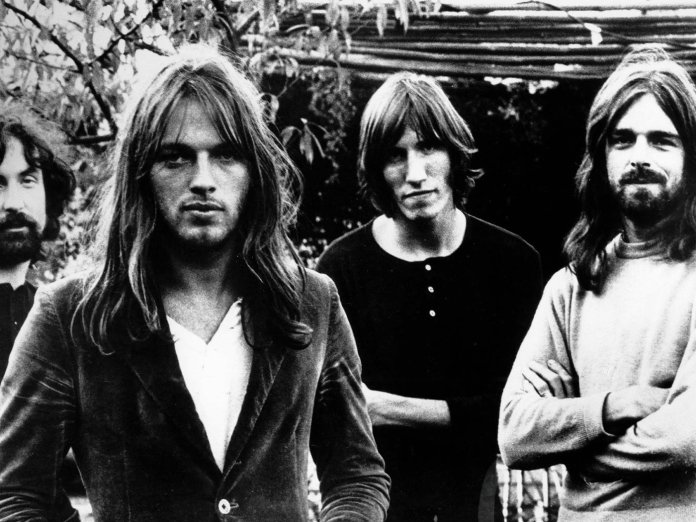The announcement of this elaborate, expensive boxset was followed by news that Roger Waters will shortly be releasing a completely new re-recording of The Dark Side Of The Moon. This is the strange situation Floyd’s most famous album finds itself in, 50 years
after release. It’s the fourth best-selling LP of all time, with an estimated 45 million copies sold, but it remains a difficult record to pin down.
The magic at work in these 10 songs, the reason why it captured the attention of the wider world, has long flummoxed even its greatest experts; namely Roger Waters, David Gilmour, Rick Wright and Nick Mason. Having spent years arguing over perceived influence, power and credit, the feeling is that even they haven’t got to grips with what makes this – a concept album with an abstract concept, an epic journey that’s over in a concise 43 minutes – such a remarkably resonant record. Asked why he’s remade the record, Waters said: “Because not enough people recognised what it’s about, what it was I was saying then.” Did 45 million people miss the point or did Waters himself?
If Dark Side… was your stoned gateway into a headier world, it’s impossible to divorce oneself from nostalgia, but it’s also difficult to think of a record that’s as sonically perfect as this, from its engineering to its use of synthesisers, sound effects and tape loops. This 50th Anniversary Deluxe Box is suitably lavish in its presentation, but it’s a testament to the sound of the original record that so much attention has been paid here to merely elaborating on the initial mixes. The new remaster sounds fantastic, but then again the basic tracks themselves are already flawlessly recorded. However, the variety of mixes – 2023 remastered, original 5.1, Atmos – feels like a convoluted diversion from the fact there’s very little here that hasn’t been heard before. Even the Live At Wembley Empire Pool, London, 1974 album doesn’t unearth anything new. There’s logic, then, in placing the final studio recordings front and centre, but an official release that included early versions, embryonic live cuts, demos and alternate mixes would have been welcome.
The real star here is the album’s tone and ‘feel’, the fairy dust that has captivated so many over the decades. That ‘feel’ is perhaps best exemplified by the alchemy that occurs when David Gilmour and Rick Wright sing together, especially on “Time”. The duo are instrumentally in perfect harmony throughout, with Gilmour’s guitar and Wright’s ethereal keyboards often indistinguishable as they engage and intertwine.
Key to the album’s unified air is the sophomoric one-two punch of the chords that weave their way through the album. The E minor to A7 that holds up the main body of “Breathe” is perhaps the most effective phrase in rock history; an elegant seesaw between melancholic resignation and euphoric optimism. That simple device, which rises again in “Time”, “Us & Them” and “Any Colour You Like”, is pure tension and release, night and day, light and dark. The quality of the material and the singularity in which it’s presented never lets up, culminating
in “Brain Damage” and “Eclipse” – composed completely by Roger Waters – one of the finest climaxes in popular music.
Waters is quick to take credit for the thematic direction of the record and, as the record’s lyricist and the band’s most dynamic personality, he was certainly Dark Side…’s driving force. Throughout, his words strike a fearless balance between being shockingly direct and then encapsulating existential confusion; it’s some achievement to convey the duality of life and express the feeling of fumbling around in the dark searching for meaning. While the album’s themes have been unfairly criticised as flimsy, or of having a naive view of mental illness, Waters’ glorious feat was being brave enough to try. “Eclipse”’s “And all that is now/And all that is gone/And all that’s to come/And everything under the sun is in tune” is succinct and startlingly perfect.
Perhaps a revelatory, Beatles-style trawl through the archives wouldn’t have suited this most mysterious of million-sellers. Dissecting Dark Side… into its lesser constituent ingredients makes little sense when the final product is such a wonderful example of what collectivism can achieve if, just for a moment, the balance between tension, talent, drive and compromise is reached. It found everyone involved, from engineer Alan Parsons, to sleeve designer Storm Thorgerson, to the four individuals in the band, operating at the very peak of their powers. In that respect, the animosity that continues to fester between the members – the tug of war over influence, credit, inspiration and business – seems even more unpleasant.
While there’s still much to delve into here, a box containing an older sibling’s scuffed second-hand copy of the album, with a joint taped to it, might have been a more fitting tribute.


